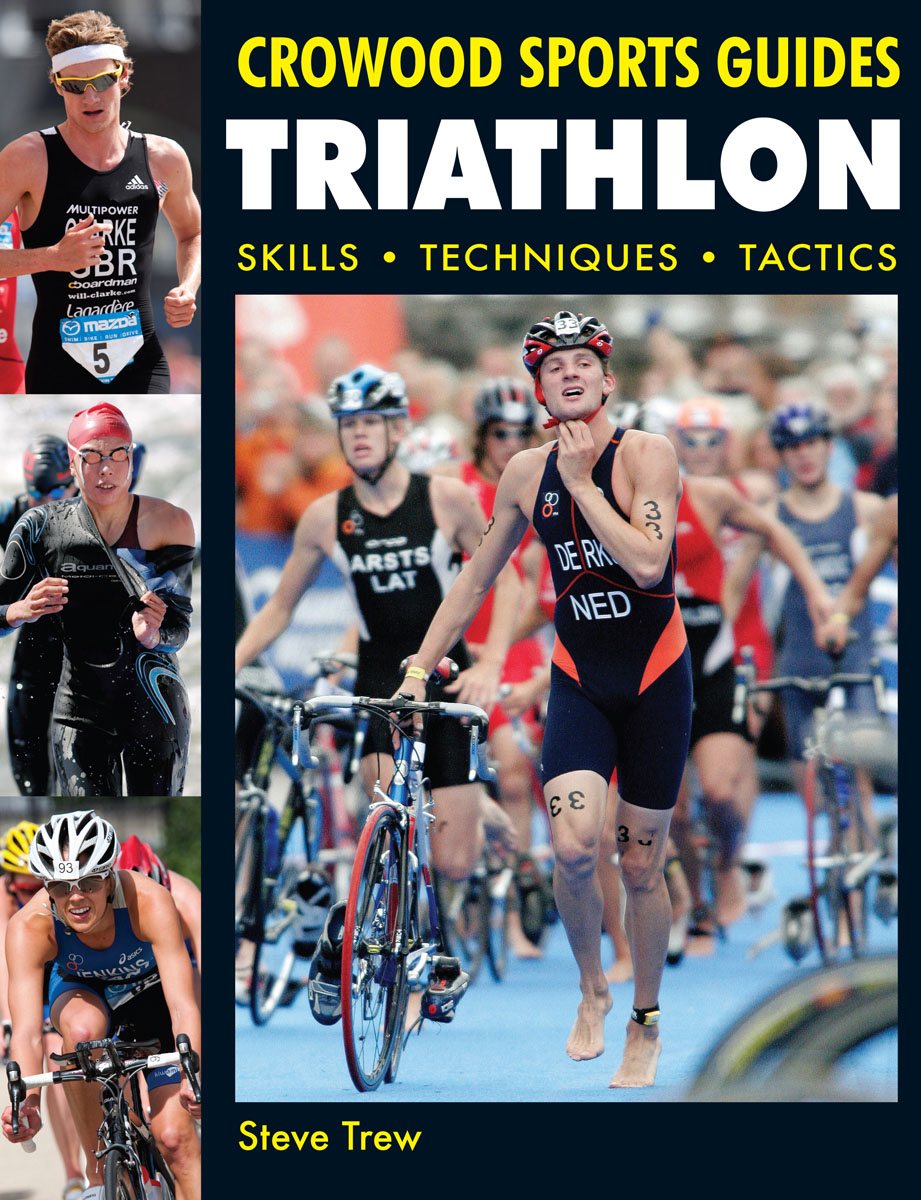
CROWOOD SPORTS GUIDES
TRIATHLON
SKILLS TECHNIQUES TACTICS
Steve Trew

THE CROWOOD PRESS
First published in 2010 by
The Crowood Press Ltd
Ramsbury, Marlborough
Wiltshire SN8 2HR
www.crowood.com
This e-book first published in 2014
The Crowood Press Ltd 2010
All rights reserved. No part of this publication may be reproduced or transmitted in any form or by any means, electronic or mechanical, including photocopy, recording, or any information storage and retrieval system, without permission in writing from the publishers.
British Library Cataloguing-in-Publication Data
A catalogue record for this book is available from the British Library.
ISBN: 978 1 84797 862 2
Disclaimer
Please note that the author and the publisher of this book are not responsible or liable, in any manner whatsoever, for any damage, injury, or adverse outcome of any kind that may result from practising, or applying, the techniques and methods and/or following the instructions described in this publication. Since the exercises and other physical activities described in this book may be too strenuous in nature for some readers to engage in safely, it is essential that a doctor is consulted before undertaking such exercises and activities.
Dedication
For Marilyn and for Shane, who changed my life even more than triathlon.
Acknowledgements
My thanks to Nigel Farrow for his inspiring photography, and to athletes Emma Dearsley and Toby Radcliffe for their patience and humour throughout all the sequence shots.
My thanks also to the athletes with whom I have worked over the years. You have all been inspirations.
CONTENTS
PREFACE
Triathlon is a sport that has caught the publics imagination; perhaps following on from the marathon boom, triathlon is seen as the all-round sport that will not only keep you fit and active but also promote an active and balanced lifestyle.
This book advises on the basic skills and techniques of the three disciplines which comprise triathlon, and provides help on balancing the training required in a multi-discipline sport. An analysis of swimming, cycling and running, along with the fourth discipline, the transition, and the particular training required to be able to deal with that, is set alongside sequence photographs that explain the appropriate techniques.
There is also advice on preparation for and analysis of racing, as well as tapering, nutrition and achieving that essential positive mental attitude.

CHAPTER 1
THE SPORT: HISTORY AND DISCIPLINES
Triathlon is a multi-discipline sport comprising swimming, cycling and running. These disciplines are normally undertaken one immediately after the other with no break in between. The changeover between the disciplines is called the transition.
Triathlon History
Popular myth has it that the sport of triathlon began in Hawaii, but this is not true: triathlons roots can be traced back to sunny, southern California in 1974, at Mission Bay in San Diego. Jack Johnstone and Don Shanahan organized this triathlon, taking over and moving on from a swim- and-run biathlon staged the previous year. Jack Johnstone added a bike discipline, and the sport of triathlon was born. However, triathlon had very little initial impact. Very slowly more triathlons were organized in and around the San Diego area and some were held a little further afield, though mainly still in southern California. There was no overall organization or structure at this time and both the distances of the three disciplines and the overall length of events differed widely. Often the distances would reflect the strengths and weaknesses of the race organizers and their experience, particularly if they intended taking part in their own event. There were individual races, relays, and events with two or more separate distances in some or all of the disciplines.

Fast transitions are an integral part of triathlon. Nigel Farrow
One man who did take part in that first ever triathlon in Mission Bay was a certain John Collins, and it is perhaps thanks to him that triathlon has established its current popularity. John Collins was a naval captain at the time he took part in the event; he was later promoted to commander. Just three years after the Mission Bay triathlon, Captain Collins was a competitor in the relay running event around Hawaii. After this event, in discussion with other athletes and competitors, not only runners, John Collins came up with a proposal that was to popularize triathlon. In 1977 there were three endurance events on the island of Oahu; the Waikiki rough water swim of 2.4 miles (3km), a two-day cycle event around the island of 112 miles (180km), and the Honolulu marathon of 26.2 miles (42km). In 1978 on 18 February, the dream became a reality and Gordon Haller (USA) won the first ever Ironman event in 11 hours 46 minutes. Of the 15 athletes who started the event, 12 finished. Television coverage followed in 1980 and the Ironman became too big for Oahu and was moved to the big island of Hawaii.
Triathlon achieved real fame and even notoriety in 1982. Triathlete Julie Moss was leading the womens event when, within sight of the finish line, she collapsed and began to crawl towards and over the finish line, only for Kathleen McCartney to run past her. The TV and general media coverage captured the imagination of all watching, and guaranteed continued interest from the general public, who perceived this new sport as something outside the normal run of things.
From its early beginnings in California and Hawaii, triathlon started to gain acceptance as a sport in its own right in Europe in 1982. Scott Tinley, a leading US triathlete had been commissioned by the International Management Group (IMG) to organize a triathlon in the principality of Monaco. However, Princess Grace of Monaco (formerly Hollywood film star Grace Kelly) was killed in a car crash and the race had to be abandoned. As all the planning had been done, the race was moved to Nice, France, and a number of the top Americans raced including Mark Allen who went on to win the inaugural ITU World Championships in 1989 and many Hawaii Ironman Championships.



















